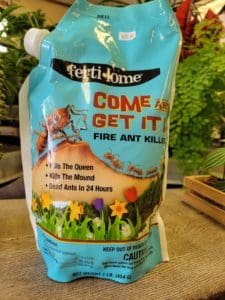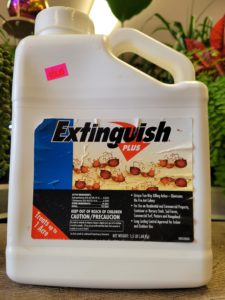Face it, we have all had run-ins with Fire Ant mounds and the painful blisters that form after they bite. Children, pets, and wildlife are especially vulnerable, as they are often unaware of the mounds until the ants begin biting.
There are several options for controlling (but unfortunately not eradicating) Imported Fire Ants:
The Two Step Method:
Step One involves broadcasting a fire ant bait over the entire area once or twice a year. This has the potential for reducing the colonies by 80-90%. Apply baits in the evening when no rain or irrigation is expected for at least two days.
Certified Organic products like Fertilome Come and Get It! does a good job but may take several weeks. When I apply it to my yard, I ask my neighbors if they would like to apply it to their yards as well. I have had great success with this method.

Extinguish Plus, which is not organic, contains two active ingredients which affect the digestive system and reproduction of ants. These products provide both fast acting and slow acting control. It is an appropriate product for livestock pastures.

AS ALWAYS, READ PRODUCT LABELS CAREFULLY FOR RATES AND USE PRECAUTIONS.
Step Two involves following up the broadcast treatment after allowing the ants to consume the bait (no sooner than 24 hours after bait application) with a contact insecticide as an individual mound treatment.
(Treating mounds individually is more labor intensive but may be used without the broadcast treatment in areas with fewer fire ant mounds. It also allows native ant species to be preserved.)
Mound treatments are most effective when ants are nesting close to the mound surface, as in after a rain or in warm weather.
Contact insecticides labeled for mound treatments include ones with the active ingredients carbaryl (Sevin), acephate, bifenthrin, and permethrin.
AGAIN, READ PRODUCT LABELS FOR USE INSTRUCTIONS, ESPECIALLY AROUND VEGETABLE GARDENS OR ORCHARDS.
Organic options include scalding hot water, pyrethrin, d-limonene, an extract from citrus oil, and Spinosad as a mound drench. These have little or no lasting effect and are best used when mounds are near the surface. Reapplication may be necessary.
Remember, have a plan, and don’t delay. I will never forget pulling a newborn fawn out of a Fire Ant Mound and brushing the ants off it. As landscapers, we have an expression for stepping in an ant mound: The Landscaper “Stomp”!
